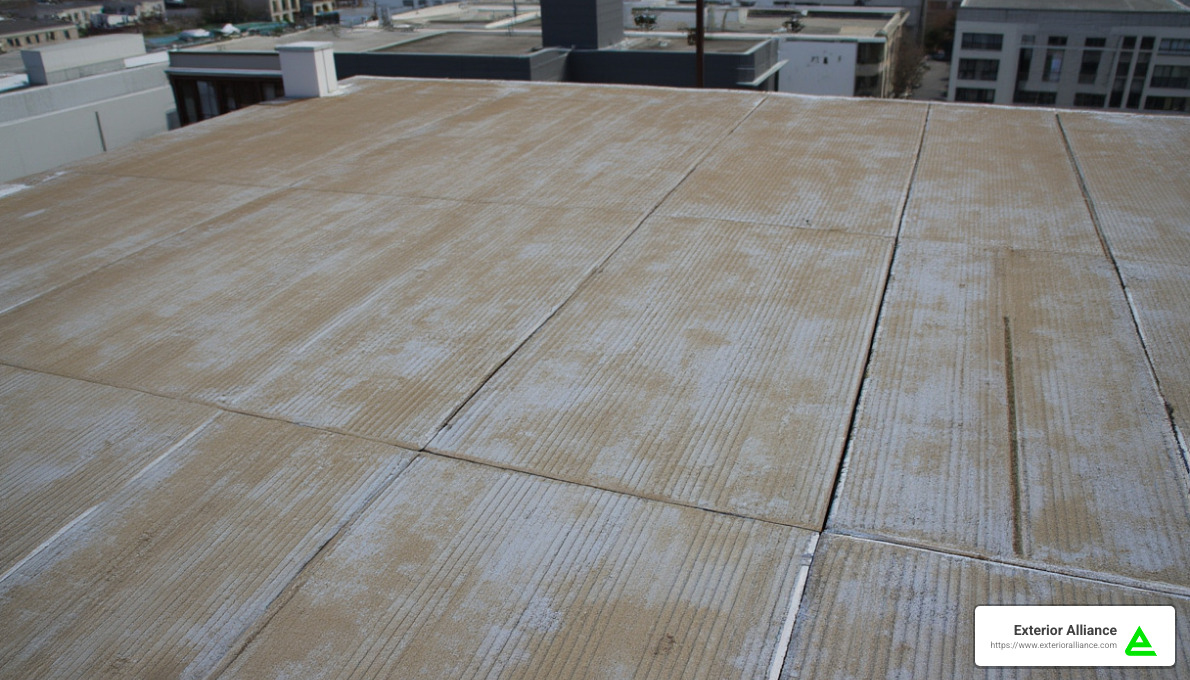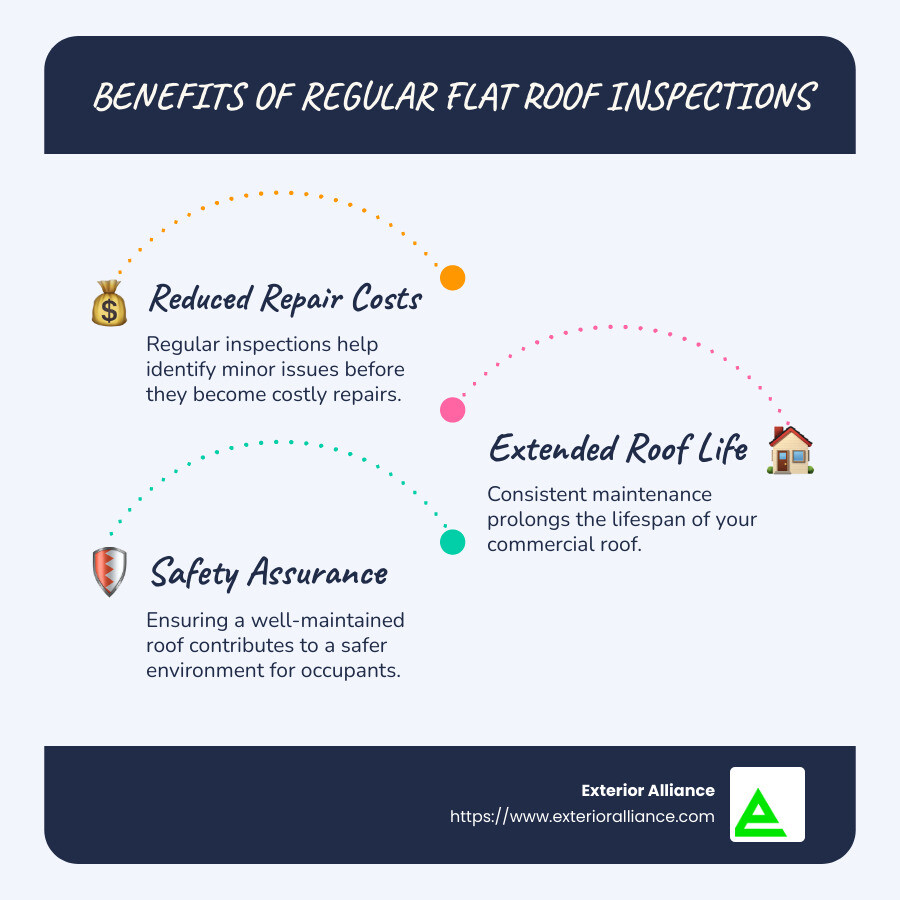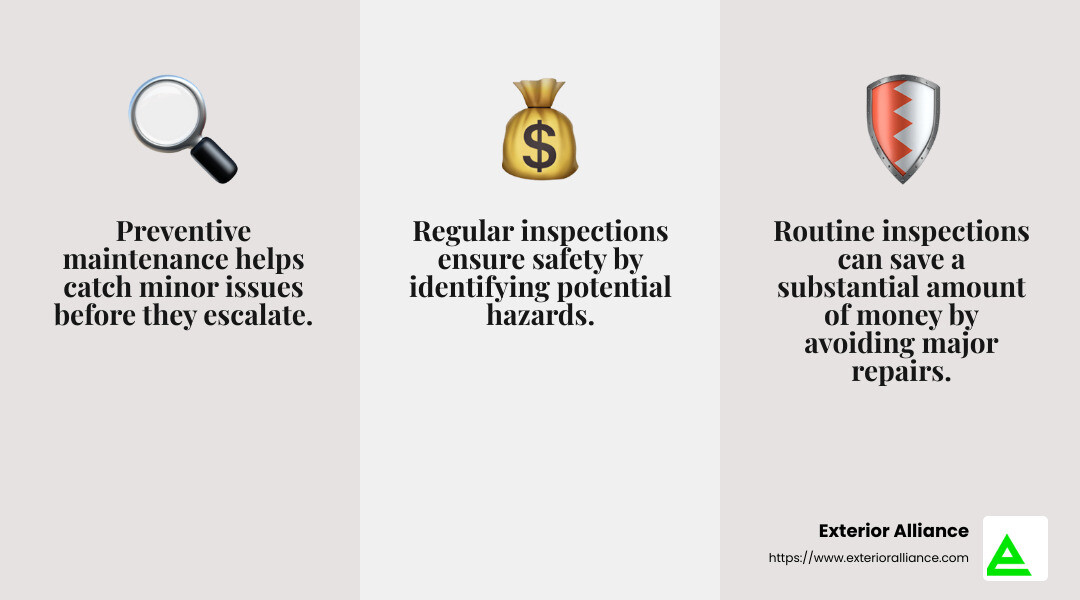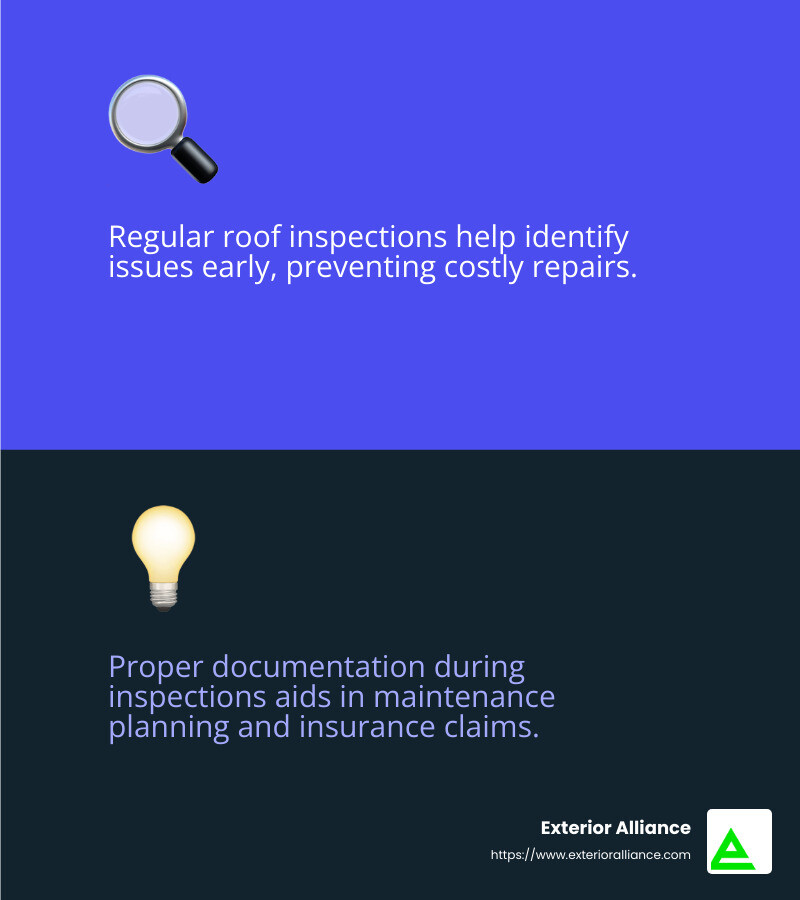
Flat roof inspection checklist isn’t just a term you stumble upon without reason—it’s a commitment to preserving the integrity and lifespan of your commercial roof. If you’re curious about how to keep your flat roof in peak condition, here’s a quick rundown that might save you time:
- Inspect Regularly: Aim for twice a year, focusing on potential damage and water pooling.
- Address Damages Promptly: Small problems can escalate quickly, so fix them early.
- Clean Gutters and Drains: Prevent blockages that lead to water damage.
- Hire Professionals When Needed: For thorough inspections and repairs, lean on experienced contractors.
Flat roofs are prevalent in commercial settings due to their cost-effectiveness and simple construction. But their longevity depends significantly on regular maintenance. Unlike sloped roofs that naturally shed water, flat roofs are more prone to water retention and damage. Hence, the necessity of routine checks and maintenance. Ignoring this can lead to expensive repairs or even a total roof replacement.
By adopting a proactive approach to maintenance, property owners can improve roof performance and avoid costly repairs. A well-maintained roof not only shields your property from the elements but also secures your investment for years to come.

Importance of Regular Flat Roof Inspections
Regular flat roof inspections are crucial for three main reasons: preventive maintenance, cost savings, and safety.
Preventive Maintenance
Think of inspections as your roof’s regular health check-ups. By catching minor issues early, you can prevent them from snowballing into major problems. For instance, small cracks or minor ponding could lead to significant water damage if left unchecked. Regular inspections allow you to address these issues before they escalate.
Cost Savings
Routine inspections can save you a substantial amount of money in the long run. How? By identifying and fixing problems early, you avoid the high costs associated with major repairs or replacements. For example, fixing a minor leak is far less expensive than dealing with extensive water damage or mold remediation.

Safety
Safety is another critical reason to perform regular inspections. A damaged roof can pose serious safety risks, not just for the building structure but also for the people inside. Loose materials or leaks can lead to accidents or health hazards. Regular inspections help ensure that your roof remains safe and secure, protecting both people and property.
In summary, a flat roof inspection checklist isn’t just a tool—it’s an essential part of maintaining your commercial property. By prioritizing preventive maintenance, you’ll save money and keep your building safe. Next, we’ll explore the essential tools you need to carry out these inspections effectively.
Flat Roof Inspection Checklist
When it comes to maintaining your commercial flat roof, having a flat roof inspection checklist is key. This checklist ensures nothing is overlooked during inspections, helping to extend your roof’s lifespan and prevent costly repairs.
Essential Tools for Inspection
Before you start the inspection, gather your toolkit. Here’s what you’ll need:
- Camera: Capture clear images of any damage or areas of concern. Photos can help track changes over time and are useful for maintenance records.
- Flashlight: Some parts of the roof might be in shadow or have low visibility. A strong LED flashlight will help you see into dark corners or under equipment.
- Tape Measure: Measure the size of any damage, ponding areas, or other issues. Accurate measurements are crucial for repairs and insurance claims.
These tools are essential for a thorough inspection. They help you document conditions accurately and ensure you have all the information you need to make informed decisions.
Key Areas to Inspect
Once you have your tools ready, it’s time to focus on specific areas of your roof:
- Visible Damage: Look for obvious signs of damage like cracks, punctures, or blisters. These can indicate underlying issues that need immediate attention.
- Wear and Tear: Check for age-related problems such as worn flashing or rust on metal parts. These issues can compromise your roof’s integrity if not addressed.
- Ponding Water: Flat roofs are prone to water accumulation, known as ponding. Use your tape measure to determine the depth and size of these areas. Ponding can lead to leaks and structural damage if not resolved.

Record Keeping and Triage
While inspecting, keep detailed records. Note down the location and condition of each issue. This information is vital for planning maintenance and repair work.
- Triage System: Use a simple triage system to categorize each issue:
- Good: No action needed.
- Fair: Monitor the situation but no immediate action required.
- Bad: Requires immediate attention to prevent further damage.
By maintaining thorough records and using a triage system, you can prioritize repairs and ensure your roof remains in good condition.
In the next section, we will dig into common flat roof issues and how to address them effectively.
Common Flat Roof Issues
Flat roofs are popular for commercial buildings, but they come with their own set of challenges. Knowing what to look for can save you time and money.
Identifying and Addressing Cracks
Cracks are a common issue on flat roofs. They can form due to thermal movement, where the roof expands and contracts with temperature changes. Over time, this can cause the material to crack or buckle.
- Ponding and Blistering: These occur when water sits on the roof for extended periods. Ponding can lead to leaks, while blistering happens when trapped moisture expands, causing bubbles in the roofing material.
To address these issues, regularly inspect your roof for signs of cracking, especially after extreme weather. Seal any small cracks quickly to prevent them from becoming larger problems.
Managing Water Damage
Water is a flat roof’s biggest enemy. Effective drainage systems are crucial to prevent water damage.
- Drainage, Gutters, and Downspouts: Ensure these components are clear of debris. Clogged gutters can lead to water pooling on the roof, increasing the risk of leaks and structural damage.
Regularly check and clean your gutters and downspouts to keep water flowing away from the roof. If you notice water pooling, it might be time to improve your drainage system or add more outlets.
By staying vigilant about these common issues, you can keep your flat roof in good shape and avoid costly repairs. In the next section, we’ll explore seasonal considerations for flat roof maintenance.
Seasonal Considerations for Flat Roof Maintenance
Flat roofs require specific maintenance strategies depending on the season to ensure they remain in optimal condition. Let’s explore how to prepare your flat roof for winter and summer.
Preparing for Winter
Winter can be particularly harsh on flat roofs. Cold weather, snow, and ice can cause significant damage if you’re not prepared.
- Roof Leaks and Thermal Shock: As temperatures drop, thermal shock can occur. This happens when the roof materials contract rapidly, leading to cracks and potential leaks. Regular inspections can help catch these issues early.
- Frozen Gutters and Snow Buildup: Snow and ice can block gutters, causing water to back up and pool on the roof. This increases the risk of leaks and structural damage. Make sure to clear gutters and downspouts to allow water to flow freely.
- Snow Removal: Heavy snow buildup can add excessive weight to your roof, risking collapse. If safe, use a roof rake to remove snow. If not, hire professionals to do the job.
Proactive winter maintenance can prevent many of these problems, saving you from costly repairs.
Summer Maintenance Tips
Summer brings its own challenges, like heat expansion and wind damage, which can affect the integrity of flat roofs.
- Heat Expansion: High temperatures can cause roofing materials to expand, leading to cracks or blisters. Regular inspections can help identify these issues before they worsen.
- Wind Damage and Debris Removal: Summer storms can bring strong winds that dislodge roofing materials or deposit debris on the roof. After storms, check for any loose materials or blocked drainage systems.
- Routine Cleaning: Keep the roof clear of leaves, twigs, and other debris. This ensures proper drainage and reduces the risk of ponding water.
By addressing these seasonal considerations, you can extend the life of your flat roof and maintain its protective qualities. Next, we’ll dive into frequently asked questions about flat roof inspection checklists.
Frequently Asked Questions about Flat Roof Inspection Checklists
How do you inspect a flat roof?
Inspecting a flat roof may seem daunting, but breaking it down into simple steps can help. Start by removing debris like leaves and branches. This prevents drainage issues and allows you to see the roof surface clearly.
Next, check the edge strips for signs of wear or damage. These strips protect the roof from water infiltration. If they’re loose or damaged, they need attention.
Look for ponding signs—areas where water pools after a rain. Ponding can lead to leaks and structural damage, so it’s crucial to address this early.
What is the most common defect in a flat roof?
One of the most common defects in flat roofs is cracks. These can occur due to thermal movement, where temperature changes cause the roofing material to expand and contract. Over time, this can lead to cracks or even blisters.
Pooling water is another typical issue. It can result from poor drainage or an uneven roof surface. Long-term pooling can cause leaks and accelerate roof deterioration.
How to test a flat roof for leaks?
Testing for leaks involves a few key steps. First, examine the flashing and seams for any visible gaps or damage. These areas are common sources of leaks.
For a more advanced inspection, use a thermal camera. This tool detects temperature differences, helping to identify moisture trapped beneath the roof surface.
By understanding how to inspect and identify common defects, you can maintain your flat roof’s integrity and prevent costly repairs. Let’s move on to explore the role of professional inspections in maintaining flat roofs.
Conclusion
Flat roofs play a vital role in protecting commercial properties, and regular inspections are crucial to maintaining their integrity. As we’ve discussed, common issues like cracks, pooling water, and thermal movement can lead to significant damage if not addressed promptly. That’s where professional inspection and repair strategies come into play.
At Exterior Alliance, we specialize in providing thorough and expert flat roof inspections. Our team is trained to identify even the smallest issues before they become major problems. We use advanced tools, like thermal cameras, to detect hidden leaks and moisture, ensuring a comprehensive assessment of your roof’s condition.
Our commitment to quality and excellence means that we don’t just identify problems; we offer effective repair strategies custom to your roof’s specific needs. Whether it’s addressing drainage issues or repairing damaged flashing, our goal is to extend the lifespan of your roof and protect your investment.
By choosing Exterior Alliance, you’re not just getting a service provider—you’re partnering with a team dedicated to safeguarding your property. Trust us for all your flat roof inspection and maintenance needs.
For more information on how we can help maintain your flat roof, visit our commercial roofing services page. Let us provide you with the peace of mind that comes from knowing your roof is in expert hands.

